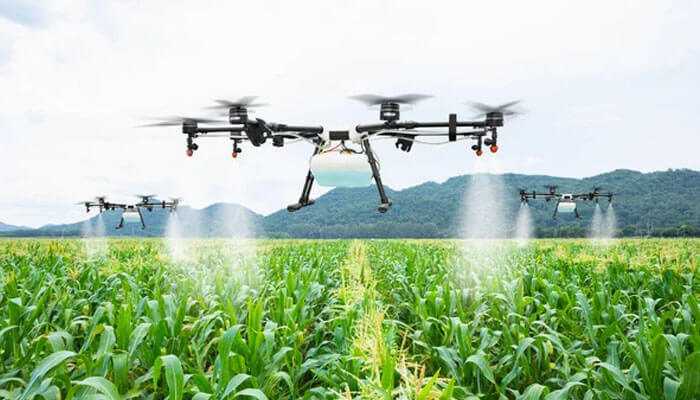The Future of Agriculture Through Drone Technology
Drone technology improves sustainability, efficiency, and production in agriculture, revolutionizing farming practices and shaping the future of agriculture. Drones can revolutionize the landscape through precision farming, automated tracking, and information-driven selection. For farmers everywhere, this generation embarks on a new era of sustainability and manufacturing.
An Overview Of India’s Current Agriculture Situation
For a wide variety of Indians, agriculture is their primary source of income. India has a larger number of buffalo than any other country in the world, and it also has a top-notch amount of land committed to developing flowers, inclusive of wheat, cotton, rice, and different specific items. Aside from this, America’s agricultural surroundings have noticed rapid development and non-preventive exchange. Improvements in technology and medicinal drugs have made the use of clinical agriculture practices possible. Regenerative farming and agricultural drones are examples of this.
The Future of Drones in Indian Agriculture: Key Drone Technology Trends
Although drones have long been implemented in agriculture, their use has improved as a result of the latest upgrades within the industry. By 2030, drone usage in India’s agriculture business enterprise will gain $121.43 million, or 2% of general agricultural gadget fees, at a compound annual growth rate (CAGR) of 38.5%, consistent with Frost & Sullivan. The market is crafted from more than 50% spraying operations.
Drone Technology Trends Shaping the Future of Agriculture
1. Advanced Sensors and Imaging:
Sensors and imaging technology like LiDAR, multispectral, and thermal cameras are already not unusual abilities on drones. With the sensors, drones can take clear photos, find subjects with accuracy, and acquire critical facts for an entire lot of functions, collectively agricultural tracking, infrastructure inspection, and catastrophe treatment.
2. Autonomous Navigation:
Drones’ potential to navigate autonomously is enhancing each day, permitting them to fly predetermined routes, keep away from limitations, and perform hard tasks without assistance from humans. Drone development is increasingly being utilized in areas such as delivery, mapping, and surveillance, where performance and safety rely on the ability of the device to operate autonomously. For more insights on drone operations, visit https://www.part107.com/drone-pilots-in-florence-south-carolina.
3. Extended Flight Times and Payload Capacities:
Drone talents have been transformed by recent developments in battery technology and drone format, which think about longer flight instances and large payload capacity. This advancement has made it possible for drones to perform correctly in quite a few eventualities and do challenging jobs without difficulty. These advancements are key to the Future of Agriculture, where drones have superior applications across several sectors and have appreciably stepped forward in terms of operational effectiveness by staying within the air for prolonged periods, overlaying massive areas, and carrying large cargo.
4. AI and Machine Learning Integration:
AI and machine learning integrations are being integrated into drone structures to enhance their abilities in information analysis, object recognition, and decision-making. These technologies permit drones to process big datasets in real time, extract actionable insights, and adapt their behavior primarily based on changing environmental conditions.
5. Edge Computing and Onboard Processing:
Drones are being prepared with edge computing systems to process records regionally and lessen the need for cloud-based total computing. Drones might also perform in regions with restricted or no community access, delay and response times through sporting-out truth assessment and picture processing onboard, playing a crucial role in the future of agriculture.
6. Swarm Technology:

7. Regulatory Developments:
To maintain security and privacy while keeping up with technical upgrades, the regulatory frameworks governing drone operations are changing. To permit the safe integration of drones into the atmosphere, governments around the world are setting legal guidelines and recommendations into place for drone registration, pilot certification, airspace management, and data protection.
8. Vertical Takeoff and Landing (VTOL) Drones:
Fixed-wing and multirotor drone talents come together in VTOL drones, which permit vertical takeoff and landing in addition to a transition to horizontal flight for extra speed and persistence. These adaptable drones are best for obligations like surveying, aerial mapping, and monitoring in urban and rural settings, playing an essential role in the future of agriculture.
9. Hybrid and Electric Propulsion:
Drone design is beginning to apply hybrid and electric propulsion systems due to the fact they may be extra strong, less noisy, and bring less pollution than traditional combustion engines. The use of electric drones for package deal transport, urban air transportation, and environmental tracking is developing in reputation.
10. Customization and Modularity:
Drone systems have become more and more modular and configurable, enabling customers to include payloads and components from 0.33 parties and customize drones to meet unique assignment needs. This fashion helps a vast variety of programs and use cases by enabling flexibility, scalability, and interoperability in drone systems.
Conclusion: The Future of Agriculture and Drone Technology’s Role
The agriculture industry will experience more pressure as the world’s population grows and need for food safety and sustainability grows. In this regard, drone technology is specifically high-quality as a game-changer, imparting creative answers to modern agriculture’s difficult problems. Drones are changing how farmers manipulate their operations and engage with their surroundings. Applications encompass precision farming, automatic crop spraying, remote sensing, and record analytics. With drone technology advancing and becoming more widely used, the agricultural enterprise will genuinely be reshaped, opening the door to stronger, more efficient, and more sustainable food production.
By stimulating innovation and developing new opportunities throughout industries, those elements collectively accelerate the improvement and diversity of drone technology. This progress is particularly impactful for the future of agriculture, as drone technology is going to change how we work, communicate, and interact with the environment around us as it develops further.



